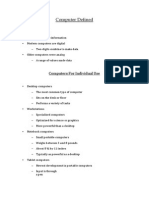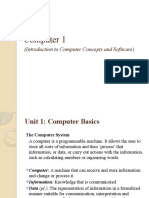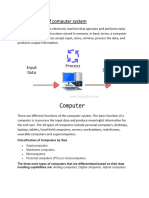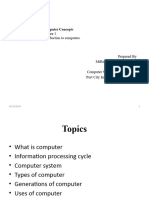0% found this document useful (0 votes)
45 views3 pagesBasics of Computer Notes
The document provides a comprehensive overview of computers, covering their definition, components (hardware and software), functions, types, generations, data representation, networks, operating systems, and basic security measures. It explains the roles of input, processing, storage, output, and control in computer operations, as well as the evolution of computer technology from vacuum tubes to AI. Additionally, it highlights the importance of security practices such as strong passwords and antivirus software.
Uploaded by
RAJU LAKSHMICopyright
© © All Rights Reserved
We take content rights seriously. If you suspect this is your content, claim it here.
Available Formats
Download as PDF, TXT or read online on Scribd
0% found this document useful (0 votes)
45 views3 pagesBasics of Computer Notes
The document provides a comprehensive overview of computers, covering their definition, components (hardware and software), functions, types, generations, data representation, networks, operating systems, and basic security measures. It explains the roles of input, processing, storage, output, and control in computer operations, as well as the evolution of computer technology from vacuum tubes to AI. Additionally, it highlights the importance of security practices such as strong passwords and antivirus software.
Uploaded by
RAJU LAKSHMICopyright
© © All Rights Reserved
We take content rights seriously. If you suspect this is your content, claim it here.
Available Formats
Download as PDF, TXT or read online on Scribd
/ 3
























































